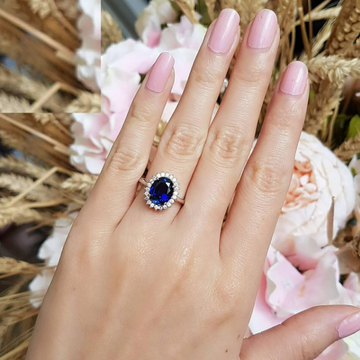Sapphire rings are more than just jewelry; they’re timeless pieces steeped in history, royalty, and a touch of magic. Known for their stunning blue hues (although sapphires come in almost every color!), their durability, and their enduring appeal, sapphire rings are a popular choice for engagement rings, anniversary gifts, and everyday wear. Whether you’re a seasoned sapphire enthusiast or new to the world of these captivating gemstones, this guide will provide you with everything you need to know to choose the perfect sapphire ring.
Why Choose a Sapphire Ring?
- Timeless Beauty: Sapphires have been admired for centuries and are known for their classic elegance.
- Durability: With a hardness of 9 on the Mohs scale, sapphires are incredibly durable and resistant to scratches, making them perfect for everyday wear.
- Variety of Colors: While blue is the most popular color, sapphires come in a rainbow of hues, including pink, yellow, green, orange, and purple (excluding red, which is a ruby).
- Symbolism: Sapphires are associated with loyalty, wisdom, truth, sincerity, and nobility.
- Royal Connection: Sapphire engagement rings have a to your personal preference. For blue sapphires, a medium to deep blue is often considered the most desirable. Research “cornflower blue” and “royal blue” sapphires.| | Clarity | Refers to the absence of inclusions (internal flaws). | Look for a sapphire with minimal inclusions that detract from its beauty. Some inclusions are natural and acceptable, but excessive inclusions can affect brilliance. | | Cut | Affects how light reflects within the sapphire and its overall brilliance. | Choose a well-cut sapphire that maximizes light reflection and displays the color evenly. Poorly cut sapphires may appear dull or lifeless. | | Carat Weight | Refers to the size of the sapphire. | Consider the overall design of the ring and the size of your finger. |yellow, white, rose), platinum, or silver. | Consider your personal preferences and skin tone. White metals enhance the blue color, while yellow or rose gold can add warmth. | | Treatment | Many sapphires are heat-treated to enhance their color and clarity. | Ask your jeweler if the stone has been treated. Heat treatment is generally considered acceptable. Be wary of sapphires with other treatments, as these can affect the stone’s long-term durability. | | Origin | Some sources (e.g., Kashmir, Burma) are known for producing high-quality sapphires, which can command higher prices. | Knowing the origin can add to the value, but prioritize color, clarity, and cut first. |
Understanding Sapphire Treatments:
| Treatment Type | Description | Impact | What to Ask |
|---|---|---|---|
| Heat Treatment | Heating the sapphire to enhance color and clarity. | Generally accepted and stable. | “Has this sapphire been heat treated?” |
| Beryllium Diffusion | Adding beryllium to the sapphire during heat treatment to improve the yellow color. | Less desirable than heat treatment alone, as it can create a shallow color. | “Has this sapphire undergone beryllium diffusion treatment?” |
| Surface Diffusion | Diffusing color onto the surface of the sapphire to improve the color. | Undesirable, as the color can be scratched or worn away. | “Has this sapphire undergone surface diffusion treatment?” |
| Fracture Filling | Filling fractures with a glass-like substance to improve clarity. | Undesirable, as the filling can be damaged over time. | “Has this sapphire been fracture filled?” |
Popular Styles of Sapphire Rings:
- Solitaire: Showcases the simple beauty of the sapphire.
- Halo: Surrounds the sapphire with smaller diamonds, enhancing its sparkle and making it appear larger. A particularly classic style for engagement rings.
- Three-Stone: Features a sapphire flanked by two diamonds or other gemstones, symbolizing the past, present, and future.
- Cluster: Features multiple sapphires clustered together to create a unique and eye-catching design.
- Vintage-Inspired: Incorporates antique details like filigree or milgrain for a touch of old-world charm.
- Eternity Band: Features a continuous row of sapphires around the entire band.
Choosing the Right Metal for Your Sapphire Ring:
- Platinum: Durable, hypoallergenic, and enhances the blue color of sapphires.
- White Gold: A more affordable alternative to platinum that also enhances the blue color.
- Yellow Gold: Adds warmth and contrast to the sapphire, creating a classic and elegant look.
- Rose Gold: Creates a romantic and feminine aesthetic, complementing pink sapphires beautifully.
Caring for Your Sapphire Ring:
- Clean Regularly: Use mild soap and warm water to clean your ring regularly.
- Avoid Harsh Chemicals: Remove your ring before using harsh chemicals or engaging in activities that could damage it.
- Store Properly: Store your sapphire ring in a soft pouch or jewelry box to prevent scratches.
- Professional Cleaning: Have your ring professionally cleaned and inspected by a jeweler at least once a year.
Styling Tips for Sapphire Rings:
- Classic Blue: A blue sapphire ring is a versatile piece that can be worn with anything.
- Color Coordination: Coordinate your sapphire ring with clothing in complementary colors, such as navy blue, white, or gray.
- Stacking: Stack multiple sapphire rings for a unique and personalized look.
- Evening Glamour: A large sapphire cocktail ring will add a touch of drama to any evening ensemble.
Conclusion: A Royal Gem for You
A sapphire ring is a stunning and enduring choice that reflects elegance, sophistication, and a touch of history. Whether you’re seeking an engagement ring, a special gift, or a treasured addition to your jewelry collection, a sapphire ring is sure to capture your heart and be admired for generations to come. From its stunning color variations to its symbolic meaning, discover the world of sapphire rings and find your perfect gem.





